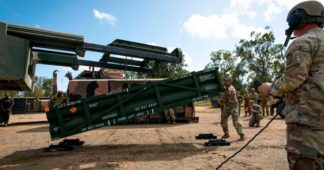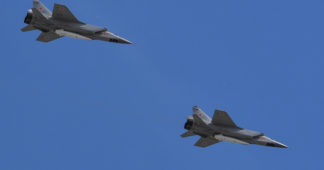By Boyko Nikolov
May 10, 2025
U.S. greenlights German rocket and Patriot missile aid to Kyiv
On Friday, the United States granted approval for Germany to transfer 125 long-range artillery rockets and 100 Patriot air-defense missiles to Ukraine, a congressional official confirmed to The New York Times.
This decision, announced on May 9, 2025, marks a significant step in bolstering Ukraine’s defense capabilities as Russian missile and drone attacks intensify. The weapons, manufactured in the U.S., require American authorization for export, even when owned by another nation, due to strict regulations governing sensitive military technology.
The move underscores Washington’s pivotal role in shaping the flow of advanced arms to Kyiv and highlights the deepening coordination among NATO allies to counter Moscow’s aggression.
The transfer comes at a critical juncture in the Russia-Ukraine conflict, now in its fourth year. Russian forces have escalated their aerial bombardments, targeting Ukrainian cities and infrastructure with a relentless barrage of missiles and drones.
A recent report from The New York Times noted that these attacks have intensified in recent weeks, despite ongoing U.S.-led peace talks. Ukraine’s air defenses, while bolstered by previous Western aid, have struggled to keep pace with the volume and sophistication of Russian strikes.
The approved weapons are expected to address urgent gaps in Ukraine’s ability to strike deep into Russian-held territory and protect its skies from advanced threats.
The long-range artillery rockets in question are widely believed to be the Army Tactical Missile System, commonly known as ATACMS. Produced by Lockheed Martin, ATACMS is a surface-to-surface ballistic missile designed to deliver precision strikes at extended ranges.
The missile, compatible with Ukraine’s existing M270 Multiple Launch Rocket Systems and High Mobility Artillery Rocket Systems, known as HIMARS, offers a range of up to 190 miles for its latest variants, such as the MGM-140B.
Each missile can carry a variety of payloads, including unitary high-explosive warheads or, in older versions, cluster munitions, though the latter’s use has been limited due to international agreements.
The ATACMS’s guidance system relies on a combination of inertial navigation and GPS, enabling it to hit targets with a circular error probable of less than 10 meters, according to a 2023 report by the Center for Strategic and International Studies.
In combat, ATACMS has proven its worth for Ukraine. In 2024, Ukrainian forces used the missile to devastating effect against Russian airfields and logistics hubs in occupied territories, including a notable strike on a military base in Crimea that destroyed several aircraft and ammunition depots.
The missile’s ability to reach deep behind enemy lines allows Ukraine to disrupt Russian supply chains and command structures, forcing Moscow to reposition critical assets further from the front. With a range far exceeding that of Ukraine’s Soviet-era artillery, ATACMS provides a tactical edge in a war where long-range precision is increasingly decisive.
The Patriot air-defense missiles, specifically the MIM-104 series, are equally critical. The Patriot system, also manufactured by Lockheed Martin, is a cornerstone of modern air defense, capable of intercepting ballistic missiles, cruise missiles, and aircraft.
The missiles in this transfer are likely the PAC-3 or PAC-3 Missile Segment Enhancement variants, which offer improved range and lethality compared to earlier models. The PAC-3 MSE, for instance, uses a hit-to-kill intercept method, relying on kinetic energy to destroy incoming threats rather than an explosive warhead.
Its advanced seeker and enhanced maneuverability make it effective against high-speed, low-observable targets, including Russia’s Iskander ballistic missiles and Shahed-136 drones.
The Patriot system’s backbone is the AN/MPQ-65 radar, which provides 360-degree coverage and can track up to 100 targets simultaneously. The radar’s ability to detect and prioritize threats at ranges exceeding 60 miles ensures rapid response times, critical in countering Russia’s layered air attacks.
Each Patriot battery, consisting of launchers, radar, and command units, can deploy up to 16 missiles, though Ukraine’s six operational batteries, as reported by the Action on Armed Violence organization in April 2025, are stretched thin across its vast territory.
The deployment of Patriot systems in Ukraine has been a game-changer since their introduction in 2023. In April 2024, a Patriot battery in Kyiv intercepted a salvo of Russian Kinzhal hypersonic missiles, a feat that underscored the system’s capability against cutting-edge threats.
However, the high cost of each PAC-3 MSE missile, estimated at $4 million, and limited production capacity have constrained Ukraine’s ability to sustain prolonged engagements. A 2025 report by Forbes highlighted Lockheed Martin’s efforts to ramp up production to 650 missiles annually by 2027, but the current output remains around 500 per year, underscoring the significance of the 100 missiles in this transfer.
The decision to approve Germany’s transfer reflects a complex interplay of military and diplomatic priorities. Germany, the second-largest provider of military aid to Ukraine after the U.S., has been a key partner in supplying air-defense systems, including IRIS-T and Gepard platforms, as well as artillery ammunition.
In April 2025, the German government announced a package that included additional Patriot missiles and 370,000 artillery shells, signaling Berlin’s commitment to Kyiv’s defense. Yet, Germany’s reluctance to supply its own Taurus long-range cruise missiles, which have a range of up to 310 miles, has sparked debate.
Chancellor Olaf Scholz has cited concerns over escalation, a stance that contrasts with the U.S. approval of ATACMS and Patriot transfers. This dynamic suggests Germany may be acting as a conduit for U.S.-made weapons to circumvent domestic political constraints in Washington, where aid to Ukraine has faced scrutiny under the current administration.
The U.S. export controls that necessitated this approval stem from the International Traffic in Arms Regulations, which govern the transfer of sensitive military technology. Even though Germany owns the weapons, their American origin requires Washington’s consent for re-export, a process that ensures alignment with U.S. strategic objectives.
This control mechanism has drawn criticism for creating bottlenecks in the flow of aid to Ukraine, particularly as Russian forces have adapted their tactics to exploit gaps in Kyiv’s defenses. A March 2025 analysis by the Institute for the Study of War noted that Russia’s increased use of Oreshnik missiles, which can evade some Western air defenses due to their high speed and altitude, has heightened the urgency for systems like Patriot.
On the battlefield, the transferred weapons are expected to make an immediate impact. Russian forces have relied heavily on long-range artillery and air strikes to maintain pressure on Ukrainian positions, particularly in the Donbas region.
The ATACMS’s ability to target logistics nodes, such as fuel depots and command posts, could disrupt these operations, forcing Russia to expend resources on protecting its rear areas. Similarly, the Patriot missiles will enhance Ukraine’s ability to shield critical infrastructure, such as power plants and transportation hubs, which have been prime targets in Russia’s campaign to cripple the country’s economy.
A May 4, 2025, report by The Times of Israel highlighted a Russian drone attack on Kyiv that damaged a shopping mall, underscoring the ongoing threat to civilian areas.
Historically, both ATACMS and Patriot have been battle-tested in conflicts beyond Ukraine. ATACMS saw extensive use during the Gulf War, where it targeted Iraqi Scud missile launchers with high accuracy.
The Patriot system, meanwhile, gained prominence in the same conflict for intercepting Iraqi missiles, though its performance against tactical ballistic missiles was later debated. Subsequent upgrades, particularly the PAC-3 series, addressed these shortcomings, making the system a linchpin of U.S. and allied air defenses.
Compared to Russia’s S-400 system, which offers a longer engagement range but lacks the Patriot’s proven track record against diverse threats, the MIM-104 remains a benchmark. Europe’s SAMP/T system, supplied to Ukraine by France and Italy, provides a complementary capability but cannot match the Patriot’s production scale or missile inventory.
The transfer also highlights broader technological and geopolitical trends. The U.S. and its allies are grappling with strained munitions stockpiles, a challenge exacerbated by the high consumption rates in Ukraine.
A March 2025 Business Insider report noted that Europe lacks a direct replacement for Patriot, with alternatives like the UK’s Gravehawk designed for slower targets. Germany’s MARS II rocket launcher, while operational in Ukraine, is less mobile than HIMARS, making it vulnerable to counter-battery fire.
These gaps underscore the U.S.’s dominant role in supplying high-end systems, a position that has drawn both reliance and frustration from European partners.
Russia’s response to the transfer remains a key variable. Moscow has previously targeted Ukrainian air-defense sites and HIMARS launchers with drone and missile strikes, and the introduction of additional ATACMS and Patriot missiles may prompt retaliatory measures.
A Foreign Policy report from March 2025 warned that Russia’s Oreshnik missile, with its ability to bypass some Western defenses, poses a growing challenge. Ukraine’s success will depend not only on the weapons themselves but also on its ability to integrate them into a layered defense strategy, combining long-range strikes with robust air protection.
The approval of this transfer also raises questions about the sustainability of Western support. While Germany’s role as an intermediary facilitates the flow of U.S.-made weapons, the quantities involved—125 ATACMS and 100 Patriot missiles—represent a fraction of Ukraine’s needs.
President Volodymyr Zelensky has repeatedly called for additional Patriot batteries, estimating a requirement of 10 to 25 systems to fully protect Ukrainian airspace. The high cost and production timelines for these systems, coupled with political uncertainties in the U.S., cast doubt on the feasibility of meeting such demands.
A January 2025 Kyiv Post report detailed a separate transfer of 90 Patriot missiles from Israel, illustrating the lengths to which Ukraine must go to secure munitions through backchannel diplomacy.
Looking ahead, the transfer is likely to strengthen Ukraine’s position in the short term, enabling targeted strikes and enhanced air defense. Yet, its long-term impact hinges on factors beyond the battlefield, including the willingness of NATO allies to maintain a steady supply of munitions and the outcome of diplomatic efforts to curb the conflict.
The U.S.’s role as gatekeeper of critical technology, while strategically advantageous, risks creating perceptions of overreach among allies, particularly as Europe seeks to develop its own defense capabilities.
In the end, the approval of Germany’s weapons transfer is a pragmatic step in a war that shows no signs of abating. It reflects the intricate balance of military necessity, alliance politics, and technological dependency that defines Ukraine’s fight for survival.
Whether this infusion of firepower can alter the conflict’s trajectory remains uncertain, but it underscores a stark reality: in modern warfare, access to advanced systems can be as decisive as the will to wield them. As Ukraine integrates these weapons, the world watches to see if they will tip the scales or merely delay an inevitable reckoning.
We remind our readers that publication of articles on our site does not mean that we agree with what is written. Our policy is to publish anything which we consider of interest, so as to assist our readers in forming their opinions. Sometimes we even publish articles with which we totally disagree, since we believe it is important for our readers to be informed on as wide a spectrum of views as possible.











